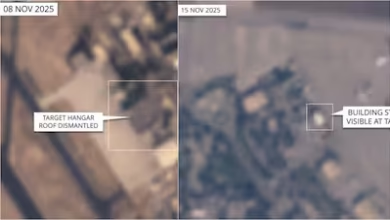China Builds New Air Defence Site Near India Border, Satellite Images Reveal Hidden Missile Shelters
Satellite visuals expose China’s expanding military infrastructure close to the India border, sparking regional security concerns.

Fresh satellite imagery has revealed that China is constructing a new and highly fortified air defence site near the India-China border in Tibet’s Gar County. The facility, located east of Pangong Tso, appears to include advanced radar units, missile launch positions, and retractable shelters designed to conceal mobile launchers – an indication of growing military preparedness in the sensitive Himalayan region.
According to defence analysts, the layout and design of the site suggest it is meant to host long-range surface-to-air missile systems, possibly an upgraded version of the HQ-9 or HQ-22 series. The retractable shelters – rarely seen in previous installations – allow China to hide its transporter-erector-launchers (TELs) from satellite detection, giving the People’s Liberation Army (PLA) a tactical advantage during any conflict scenario.
The complex also features communication towers, control centres, and vehicle bays, pointing to a semi-permanent operational base rather than a temporary deployment zone. Experts believe the site will provide enhanced air cover for Chinese forces deployed across the Western Theatre Command, including the contentious areas opposite Ladakh.
Military watchers have linked this latest development to China’s broader strategy of strengthening defences along the Line of Actual Control (LAC) following the 2020 Galwan Valley clash. Over the past few years, Beijing has significantly expanded roads, radar installations, and helipads along the border – moves that Indian security agencies are monitoring closely.
The location of this new air defence base, roughly 65 to 70 kilometres from the LAC, places it within striking range of key Indian positions, including the recently upgraded Nyoma air base in Ladakh. Defence experts say the site’s strategic positioning could help China improve its early warning and response capabilities against Indian air activity in the region.
While the Indian government has not issued an official response, defence officials reportedly remain vigilant and continue to assess satellite inputs and aerial reconnaissance data from the region. The new construction underscores the growing complexity of the India-China border standoff, where both sides have been enhancing infrastructure and troop deployments.
This latest revelation reinforces the need for India to maintain a robust deterrence posture, accelerate indigenous missile defence programs, and continue strengthening forward bases to ensure balance along the northern frontier.







Facebook Comments